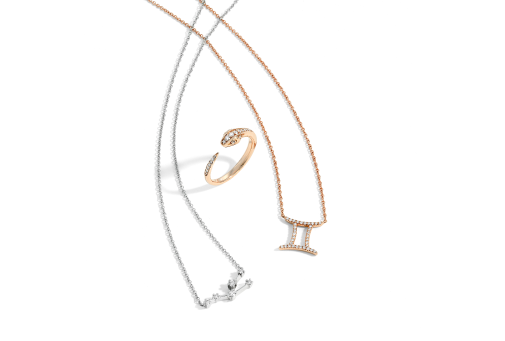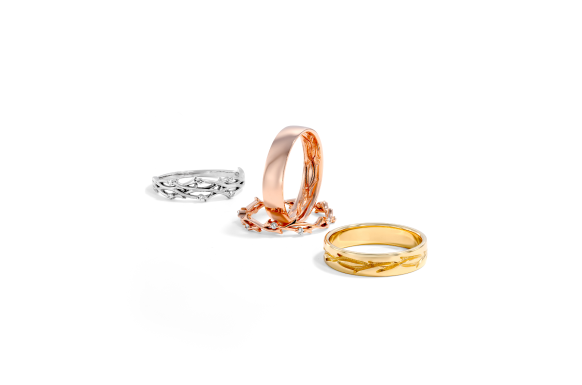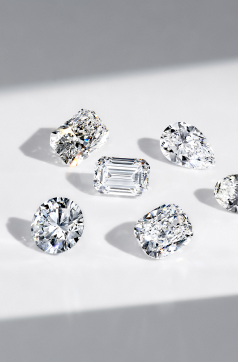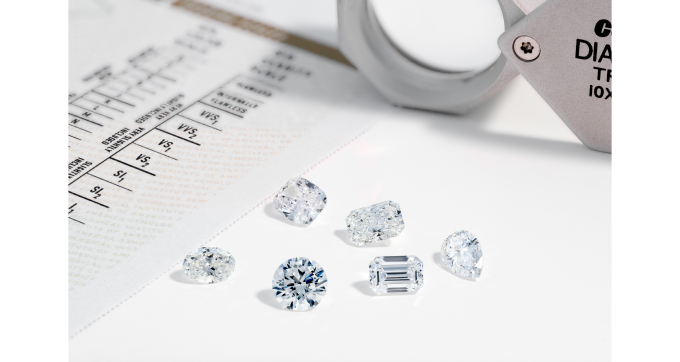Moissanite vs Diamond
Education Center
Education CenterEverything You Need to Know About Moissanite Vs. Diamonds
Moissanite is the best diamond simulant on the market today. It looks a lot like a diamond - a little more sparkle but otherwise identical - and is nearly as hard. It costs a fraction of what diamonds do, and many Keyzar customers choose it for their engagement ring’s center stone.
What is Moissanite?
Moissanite is a naturally occurring, rare mineral made of silicon and carbon. It was originally discovered in an Arizonan meteor crater, but natural moissanite is too small for jewelry. Any moissanite you’ll see in a ring, necklace, and other pieces is lab-made!
Moissanite: Advantages
If you’re looking for a center stone that’s hard and shiny but cheaper than diamonds, moissanite is a good choice. It has the following upsides.
Cost
A moissanite stone looks similar to a diamond and costs far less. That means you can go higher in carat weight without paying a fortune.
Looks
Moissanite has near-flawless clarity. You won’t see any flaws or inclusions in a good stone. Moissanite stones also offer more fire and brilliance than diamonds. Can you guess where is the moissanite and where is the diamonds? The moissanite is below.
Durability
After diamonds, moissanite is the most durable gemstone around. It has a rank of 9.25-9.5 on the Mohs hardness scale (diamonds are a 10). It doesn’t scratch, tarnish, or rub out like many other gemstones.
Sustainability
Moissanite is 100% lab-grown - never mined - so it’s both sustainable and ethical.
Moissanite: Disadvantages
Moissanite is the best diamond alternative, but it’s not quite a diamond. Here are some differences you should be aware of. Can you guess where is the moissanite and where is the diamonds? The diamond is above.
Rainbow Colors
Moissanite reflects much more color under bright light than diamonds. This gives it what’s known as the “rainbow effect”, with a lot of the sparkle coming in colors.
Intense Brilliance
Moissanites have more shine than diamonds. A diamond expert will be able to tell one apart from a diamond.
Moissanite Engagement Rings
Moissanite is a beautiful, durable gem that will last a lifetime. It makes a gorgeous center stone for engagement rings and pairs well with all settings. In these ways, it’s exactly like a diamond.
Moissanite is 100% eco-friendly, so it’s a perfect choice for your environmentally conscious partner. When choosing a setting, make sure to choose lab-grown diamond side stones to keep the ring totally sustainable!
The Science Behind Moissanite
Moissanite is a rare jewel. It’s only found in corundum deposits, kimberlite rock and some meteorites. The moissanite you can buy for your jewelry is 100% artificial and is actually carborundum or silicon carbide; not natural moissanite.
Most of the real moissanite we know about is flying around in space. It is found in dust clouds formed from carbon. Studying the Murchison meteorite prompted scientists to find that silicon carbide, which moissanite is mostly made up of, was formed far beyond our Solar System.
The History Behind Moissanite
Thousands of years ago, The Diablo Canyon meteorite fell in what is now the USA. In 1893, the French chemist Ferdinand Frederic Henri Moisson began to actively study this cosmic guest. He discovered the smallest fragments of a completely new mineral, later named "moissanite" in his honour.
On February 28, 1893, Edward Goodrich Acheson patented the formula for the production of a synthetic analogue. He invented powdered silicon carbide (SiC). This led to the large-scale production of carborundum, because Edward also invented a furnace in which synthetic material is produced to this day. Edward Acherson became the founder of the specialized company, "The Carborundum Company".
Moissanite or Not?
Here are telltale signs you're looking at moissanite and not a diamond.
Conclusion
Moissanite is a wonderful option for those looking for a diamond alternative. While these stones are different from diamonds, they are stunning gems. Moissanite offers brilliance, fire, and durability without the hefty price tag.



